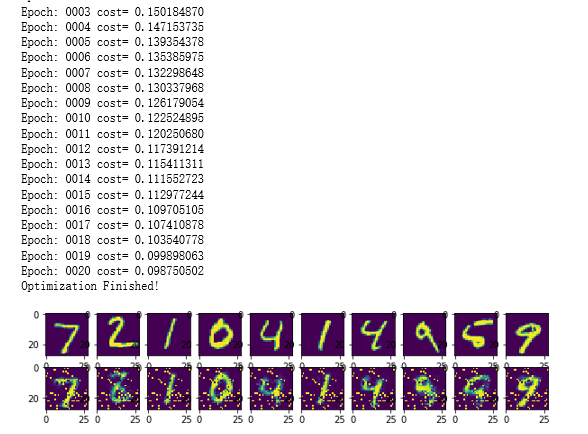吴裕雄 PYTHON 神经网络——TENSORFLOW 无监督学习处理MNIST手写数字数据集
# 导入模块
import numpy as np
import tensorflow as tf
import matplotlib.pyplot as plt # 加载数据
from tensorflow.examples.tutorials.mnist import input_data mnist = input_data.read_data_sets("E:\\MNIST_data\\", one_hot=True) #模型训练
# 设置超参数
learning_rate = 0.01 # 学习率
training_epochs = 20 # 训练轮数
batch_size = 256 # 每次训练的数据
display_step = 1 # 每隔多少轮显示一次训练结果
examples_to_show = 10 # 提示从测试集中选择10张图片取验证自动编码器的结果 # 网络参数
n_hidden_1 = 256 # 第一个隐藏层神经元个数(特征值格式)
n_hidden_2 = 128 # 第二个隐藏层神经元格式
n_input = 784 # 输入数据的特征个数 28*28=784 # 定义输入数据,无监督不需要标注数据,所以只有输入图片
X = tf.placeholder("float", [None, n_input]) #初始化每一层的权重和偏置
weights = {
'encoder_h1': tf.Variable(tf.random_normal([n_input, n_hidden_1])),
'encoder_h2': tf.Variable(tf.random_normal([n_hidden_1, n_hidden_2])),
'decoder_h1': tf.Variable(tf.random_normal([n_hidden_2, n_hidden_1])),
'decoder_h2': tf.Variable(tf.random_normal([n_hidden_1, n_input])),
}
biases = {
'encoder_b1': tf.Variable(tf.random_normal([n_hidden_1])),
'encoder_b2': tf.Variable(tf.random_normal([n_hidden_2])),
'decoder_b1': tf.Variable(tf.random_normal([n_hidden_1])),
'decoder_b2': tf.Variable(tf.random_normal([n_input])),
} #定义自动编码模型的网络结构,包括压缩和解压的过程 # 定义压缩函数
def encoder(x):
# Encoder Hidden layer with sigmoid activation #1
layer_1 = tf.nn.sigmoid(tf.add(tf.matmul(x, weights['encoder_h1']),biases['encoder_b1']))
# Decoder Hidden layer with sigmoid activation #2
layer_2 = tf.nn.sigmoid(tf.add(tf.matmul(layer_1, weights['encoder_h2']),biases['encoder_b2']))
return layer_2 # 定义解压函数
def decoder(x):
# Encoder Hidden layer with sigmoid activation #1
layer_1 = tf.nn.sigmoid(tf.add(tf.matmul(x, weights['decoder_h1']),biases['decoder_b1']))
# Decoder Hidden layer with sigmoid activation #2
layer_2 = tf.nn.sigmoid(tf.add(tf.matmul(layer_1, weights['decoder_h2']),biases['decoder_b2']))
return layer_2 # 建立模型
encoder_op = encoder(X)
decoder_op = decoder(encoder_op) # 得出预测分类值
y_pred = decoder_op
# 得出真实值,即输入值
y_true = X # 定义损失函数和优化器
cost = tf.reduce_mean(tf.pow(y_true - y_pred, 2))
optimizer = tf.train.RMSPropOptimizer(learning_rate).minimize(cost) # 初始化变量
init = tf.global_variables_initializer() # 3 训练数据及评估模型
with tf.Session() as sess:
sess.run(init)
total_batch = int(mnist.train.num_examples/batch_size)
# 开始训练
for epoch in range(training_epochs):
# Loop over all batches
for i in range(total_batch):
batch_xs, batch_ys = mnist.train.next_batch(batch_size)
# Run optimization op (backprop) and cost op (to get loss value)
_, c = sess.run([optimizer, cost], feed_dict={X: batch_xs})
# 每一轮,打印一次损失值
if epoch % display_step == 0:
print("Epoch:", '%04d' % (epoch+1),"cost=", "{:.9f}".format(c))
print("Optimization Finished!") # 对测试集应用训练好的自动编码网络
encode_decode = sess.run(
y_pred, feed_dict={X: mnist.test.images[:examples_to_show]})
# 比较测试集原始图片和自动编码网络的重建结果
f, a = plt.subplots(2, 10, figsize=(10, 2))
for i in range(examples_to_show):
a[0][i].imshow(np.reshape(mnist.test.images[i], (28, 28)))
a[1][i].imshow(np.reshape(encode_decode[i], (28, 28)))
f.show()
plt.draw()
#plt.waitforbuttonpress()

吴裕雄 PYTHON 神经网络——TENSORFLOW 无监督学习处理MNIST手写数字数据集的更多相关文章
- 吴裕雄 python 神经网络TensorFlow实现LeNet模型处理手写数字识别MNIST数据集
import tensorflow as tf tf.reset_default_graph() # 配置神经网络的参数 INPUT_NODE = 784 OUTPUT_NODE = 10 IMAGE ...
- 吴裕雄 python 神经网络——TensorFlow实现AlexNet模型处理手写数字识别MNIST数据集
import tensorflow as tf # 输入数据 from tensorflow.examples.tutorials.mnist import input_data mnist = in ...
- 吴裕雄 python 神经网络——TensorFlow 循环神经网络处理MNIST手写数字数据集
#加载TF并导入数据集 import tensorflow as tf from tensorflow.contrib import rnn from tensorflow.examples.tuto ...
- 吴裕雄 python 神经网络——TensorFlow 使用卷积神经网络训练和预测MNIST手写数据集
import tensorflow as tf import numpy as np from tensorflow.examples.tutorials.mnist import input_dat ...
- 吴裕雄 python 神经网络——TensorFlow 训练过程的可视化 TensorBoard的应用
#训练过程的可视化 ,TensorBoard的应用 #导入模块并下载数据集 import tensorflow as tf from tensorflow.examples.tutorials.mni ...
- 吴裕雄 python 神经网络——TensorFlow实现搭建基础神经网络
import numpy as np import tensorflow as tf import matplotlib.pyplot as plt def add_layer(inputs, in_ ...
- 吴裕雄 python 神经网络——TensorFlow图片预处理调整图片
import numpy as np import tensorflow as tf import matplotlib.pyplot as plt def distort_color(image, ...
- 吴裕雄 python 神经网络——TensorFlow pb文件保存方法
import tensorflow as tf from tensorflow.python.framework import graph_util v1 = tf.Variable(tf.const ...
- 吴裕雄 python 神经网络——TensorFlow 数据集高层操作
import tempfile import tensorflow as tf train_files = tf.train.match_filenames_once("E:\\output ...
随机推荐
- mybatis-plus QueryWrapper自定义查询条件
mybatis-plus QueryWrapper自定义查询条件 mybatis-plus框架功能很强大,把很多功能都集成了,比如自动生成代码结构,mybatis crud封装,分页,动态数据源等等, ...
- cookies、sessionStorage和localStorage的异同点
相同点:都是存储于客户端 不同点: 1.存储大小 cookies数据大小不能大于4k; localStorage和sessionStroage则可以达到5M: 2.有效时间 cookies在设置的有效 ...
- [POI2007] OSI-Axes of Symmetry
Description Luogu3454 BZOJ1100 Solution 把边和角顺次放入一个数组里,如果一个点为中心的回文串的半径大于\(n\),那就一定是一个对称轴.跑一遍manacher就 ...
- JVM&GC详解
1.JVM简介 JVM是java的核心和基础,在java编译器和os平台之间的虚拟处理器.它是一种利用软件方法实现的抽象的计算机基于下层的操作系统和硬件平台,可以在上面执行java的字节码程序. ja ...
- codeforces 1288E. Messenger Simulator(树状数组)
链接:https://codeforces.com/contest/1288/problem/E 题意:序列p的长度为n,初始序列为1 2 3 4 ...n,然后有m次操作,每次指定序列中一个数移动到 ...
- 常用的 19 条 MySQL 优化
一.EXPLAIN 做MySQL优化,我们要善用 EXPLAIN 查看SQL执行计划. 下面来个简单的示例,标注(1,2,3,4,5)我们要重点关注的数据 type列,连接类型.一个好的sql语句至少 ...
- 阿里云ECS服务器CentOS7配置vsftps及其问题解决
前言 之前只在虚拟机中配过FTP服务器,今天买了云服务器,发现安装vsftpd后就是连不上,通过搜索了很多资料,最后找到了解决办法,系统是CentOS7,服务器类型是ECS 阿里云安全组配置 首先进入 ...
- sql server和eclipse连接问题
最近学习java,需要用的数据库sql sever,这就有一个连接问题需要设置 首先需要下载sql server,可查看我的博客sql sever下载教程: 连接教程:eclipse连接sql ser ...
- EF database first
https://www.cnblogs.com/net064/p/8024150.html 1.EF简介ADO.NET Entity Framework 是微软以 ADO.NET 为基础所发展出来的对 ...
- DisplayNameFor()方法的工作原理
DisplayNameFor()方法的工作原理原创Peter Yelnav 最后发布于2018-11-23 11:09:51 阅读数 1308 收藏展开最近研究了一下ASP.NET MVC,困惑于视图 ...
